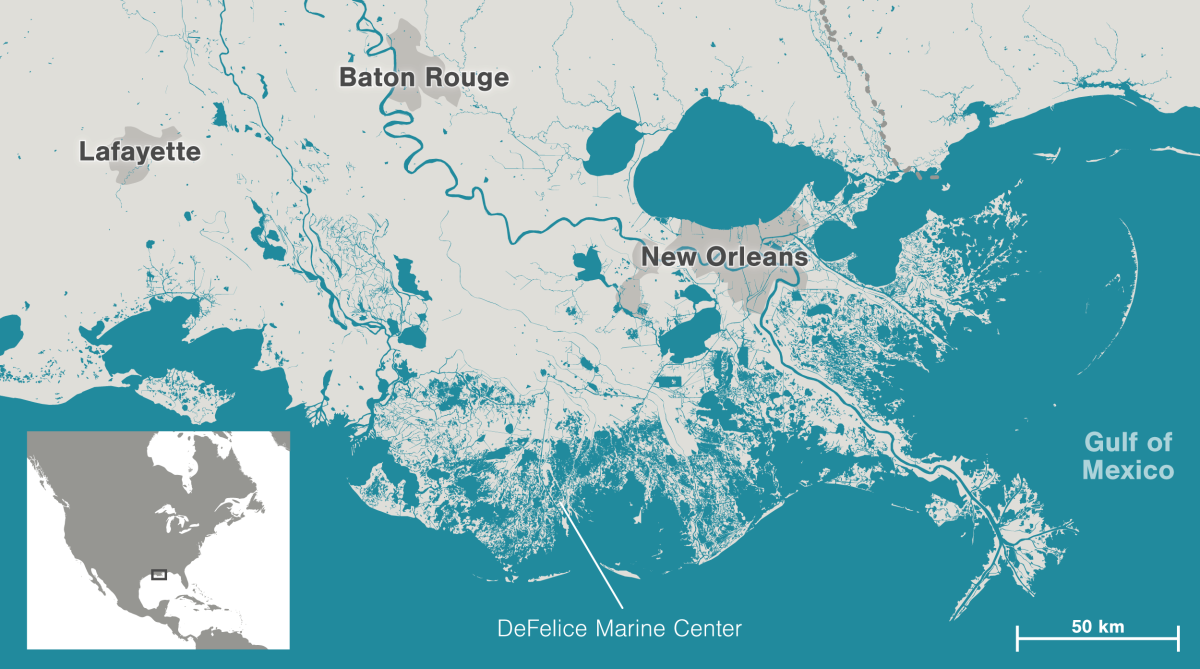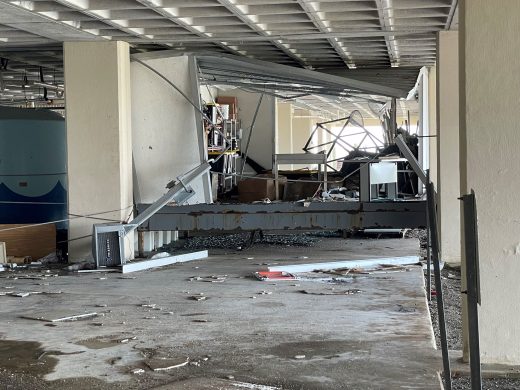The Marine Lab in the Path of Fury
At the DeFelice Marine Center, researchers and staff are living, working, and adapting to climate change in real time.
Article body copy
As the storm first gathered strength in the Gulf of Mexico, its future path was indecipherable. Its capacity for damage, though, was clear. The water was warm and the air was thick and humid—the recipe for a potentially historic tempest. On Thursday, August 26, 2021, just hours after the system was classified as a tropical depression, Louisiana’s governor declared a state of emergency: every resident along the state’s coastline needed to prepare for a major hurricane.
Louisiana is protected by a series of levees that zig and zag along the coastline—walls of earth meant to block hurricane-driven waves from reaching the state’s bigger towns and villages. Floodgates clasp shut so that local bayous don’t overflow with storm surge. By necessity, though, the DeFelice Marine Center stands outside this system of defenses.
The building—a roughly 7,000-square-meter concrete fortress that rises amid Louisiana’s marshland—is one of the state’s premier marine labs: a warren of laboratories and classrooms that houses US $7-million in equipment and other assets. Sixty staff members assist the center’s eight faculty scientists, who conduct research into the biology, ecology, chemistry, and geology of the state’s coastal environment. The building sits just north of Cocodrie, a village of shrimpers, crabbers, and weekenders near the mouth of Bayou Petit Caillou, on a strip of land that dangles like a loose thread into Terrebonne Bay.
Even before the governor declared a state of emergency, the hurricane threat had set off a clockwork sequence of preparations at the marine center. Staff relocated boats, forklifts, and tractors to Houma, a city that stands on slightly higher ground less than 50 kilometers to the north. Workers dropped sandbags at the bases of the marine center’s ground-floor doors, hoping to keep the force of incoming waves from ripping the doors off their hinges. They strapped down the 50,000-liter tanks, filled with ocean water for research purposes, that are kept under the building. Because the building’s new storm shutters had not yet been finished, contractors placed wood panels over the unprotected windows. Scientists carried their most expensive equipment—portable analyzers used to measure gas fluxes in wetlands, flowmeters, laboratory computers—to the center of the building, away from the windows. Then they draped sheets of thick plastic over everything as further protection in the case of a roof leak.
By early Friday afternoon—two days before the storm, now named Ida, was projected to make landfall—the few remaining employees headed to their homes. Some hunkered down, unwilling to leave the coast; others packed their bags and joined the caravan of cars plugging up Louisiana’s highways, seeking motel rooms and guest bedrooms farther from the storm.
Typically, wherever the scientists are sheltered, they can take measure of conditions in Cocodrie by tuning into the marine center’s weather cameras. But at 2:00 p.m. on Sunday, August 29, just as the storm made landfall, the marine center’s power failed. The cameras went dark. A nervous day passed before anyone could make it south to assess the damage. Everyone knew it would be grim: Ida had made landfall as a Category 4 hurricane, which, per official definition, is capable of catastrophic damage. (Were the wind just a handful of kilometers faster, the storm would have become a “Cat 5,” the highest possible classification.)
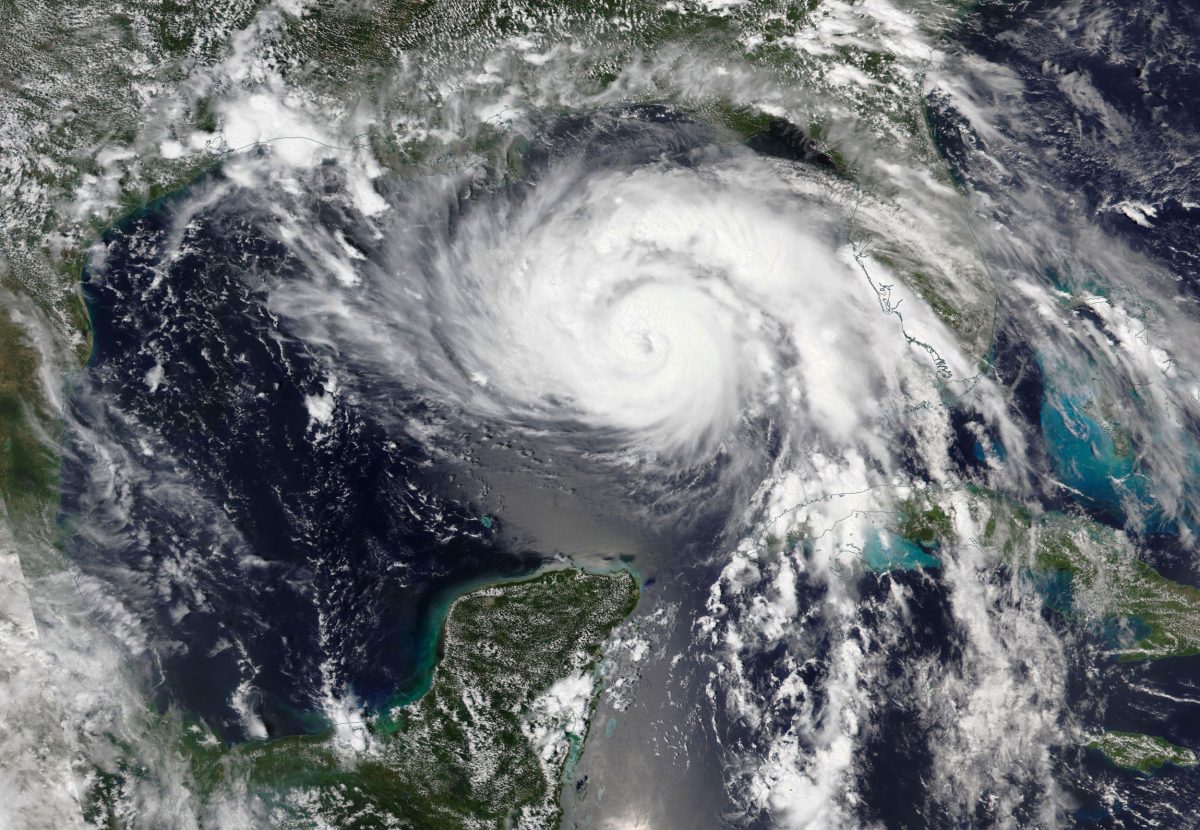
As the hurricane season becomes longer and the storms stronger, the DeFelice Marine Center in Louisiana is adapting: its future is now. Photo by Geopix/NASA/Alamy Stock Photo
The first reports from the coast revealed a landscape of overturned shrimp boats and whole homes lifted off their pilings and dumped in the bayou. The marine center sustained significant damage, and there was little clarity about when power might be restored. The storm was the latest reminder of the staff’s constant conundrum: in a world of changing weather, the center’s climate research was becoming increasingly relevant. But what do you do when the object of your study becomes a threat to the study itself?
The DeFelice Marine Center is the headquarters of the Louisiana Universities Marine Consortium (LUMCON), an organization that promotes research and education into the state’s coastal and marine environments. As its name implies, LUMCON partners with all of Louisiana’s two dozen universities, though it exists as its own institution. The marine center is, for some of its visitors, a summer camp, offering several week-long overnight experiences for middle and high school students each June and July. Add in school field trips, and the site is visited by thousands of students each year—at least in non-pandemic years. But this is not just kid stuff: LUMCON is also an elite laboratory. Eight faculty scientists have offices on campus, where they investigate, among other questions, how the local coastal environment affects carbon cycling; how climate change is impacting the ecological communities of the Gulf of Mexico; and what effects various restoration efforts, meant to offset rising oceans, may have on sea life here.
Before Ida, a faculty biologist named Craig McClain had been working on a study of the benthic communities—the life in and on the seabed—in Terrebonne Bay. McClain began collecting data in 2017; every year since, Louisiana has suffered from a hurricane or a tropical storm. At least nine storms in five years: that’s a huge uptick compared with the historical average of two storms every three years. All that climate-induced chaos complicates the study. “I can’t talk about impacts of hurricanes and tropical storms on the system,” McClain says, “because I haven’t seen it in any other way.” Then again, he notes, this is the new paradigm: the storms are the norm in our climate-changed world.
In June of this year, 10 months after Ida, when I visit the marine center, I find sheets of brown paper lining the floors. Teams of contractors are applying Sheetrock to the walls. “As you can see—repairs,” Katie Maier, LUMCON’s executive assistant, says as she escorts me down the hall. “Still doing repairs.” She allows me to peek through a window into the aquaculture laboratory. She can’t bring me in, she says, because the floor is unsteady.
LUMCON was in some ways lucky. Hurricanes in the northern hemisphere spin counterclockwise, which means that when storms drift up from the Gulf of Mexico, the winds push a storm surge of ocean water to the northeast. Because the marine center lay to the west of Ida’s center, the building was spared storm-surge flooding. But the winds gusted to 240 kilometers per hour, which puts this storm among the most intense in state history in terms of wind speed at landfall. The storm sat just north of Cocodrie for hours. Several windows shattered, debris raked across the facility’s roof, and water poured into offices and dormitories.
Though spared the worst scenario, the damage to the marine center after Hurricane Ida still meant that science took a back seat to repairs for a while. Photos courtesy of LUMCON
Brian Roberts, who then served as LUMCON’s associate director of science, returned to the marine center two days after the storm. He found his office windows had held, but the roaring winds had bent the storm shutters and pressed mud through the seams along the edges of the window frames. Several centimeters of muck buried his rug. The marine center’s generator had failed, and the warm, wet conditions created a perfect habitat for mold, which eventually covered the wall separating Roberts’s office and waiting room. Later, he decided to have the wall removed.
Temperatures that week often topped 32 °C and the air was all but saturated with humidity. It took nearly a week to repair the marine center’s generator, and even then, the air conditioning was on the fritz, making conditions inside the building quite uncomfortable. Roberts had spent more than a decade collecting water and soil from the marsh near Cocodrie—frozen samples he hoped to one day test to learn how the environment was changing alongside the climate. LUMCON’s walk-in freezer had failed in the storm, but Roberts got his hands on smaller freezers and refrigerators. He drove south from his home in Houma nearly every day so he could shuffle the samples, giving each a turn in the freezers that were managing to stay coolest. Even this he could only accomplish because LUMCON’s boats were parked in the marina, providing a bit of relieving air conditioning after his stints inside the hot building. Ultimately, the freezers could not keep up, and many of the samples were ruined.
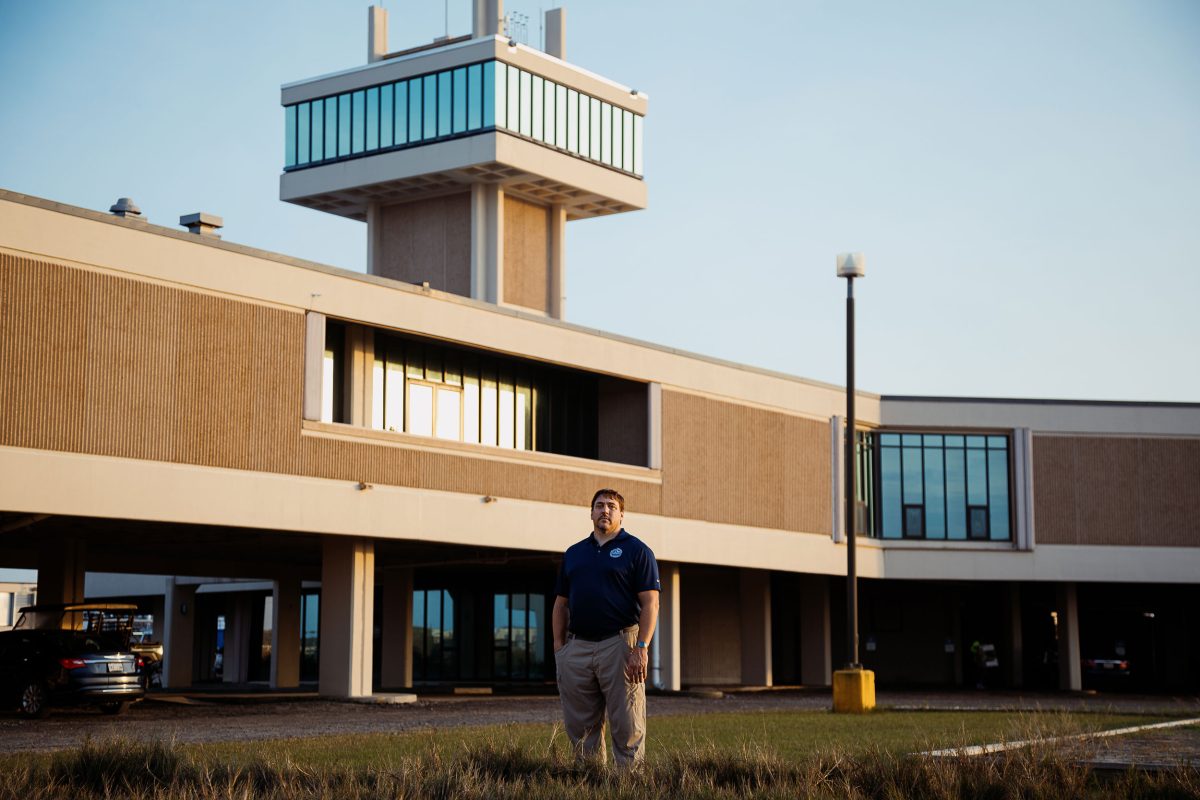
The marine center is the headquarters of the Louisiana Universities Marine Consortium (LUMCON), an organization that promotes research into the state’s coastal and marine environments. Brian Roberts, above, is LUMCON’s interim executive director. Photo by Bryan Tarnowski
The storm had merely injured the DeFelice Marine Center. For those who lived in the surrounding communities, Ida’s devastation was life-altering. Roberts and LUMCON’s other leaders scrambled to track down the consortium’s 70 staff members; some had no power and no working cell phone, and could be verified as survivors only when conditions allowed officials to reach their homes. At least six staff members lost their homes; almost no one on staff had power for days afterward—for weeks, in most cases. Quickly, though, science journalists began to call to ask what the storm meant for the facility’s research. “And I’m like, ‘We’re not even on that step yet,’” says McClain, who then served as LUMCON’s executive director. “You’re talking about step eight or nine, and we’re on step one, which is covering basic necessities of life. And so it was just kind of a weird conversation to have.”
Even now, more than a year after the storm, it’s hard to quantify its impacts. Roberts—named LUMCON’s interim executive director this July, a few weeks after my visit—couldn’t think of a consortium researcher who had to abandon a project. But for more than a month after the storm, almost no scientific work was done. Data sets, some spanning decades, now feature a lacuna. What exactly was happening in the coastal ecosystems in the days and weeks after this climate-driven storm? We can never know. The spoiled samples, meanwhile, had been meant as grist for future research projects, some not yet even conceived. The number of insights lost in the storm is an unknowable unknown.
LUMCOM’s perilous position—studying climate change day after day on the front line—is more extreme than at many other labs. But the marine center is not alone in this struggle. At the Rocky Mountain Biological Laboratory’s field station, north of Crested Butte, Colorado, changing avalanche patterns already threaten access. Wildfires have been striking the Rockies with increasing frequency, too, and Ian Billick, the laboratory’s executive director, worries that the resulting smoke might lead to summertime shutdowns within the next few years. “Just at the time when society needs more from marine and field scientists, it’s harder to provide that because of the stresses associated with climate change,” he says.
The rising oceans, though, will cause more than temporary shutdowns: they are an existential threat to marine research facilities everywhere. Woods Hole, Massachusetts, is a major research hub, home to the US government’s first official marine research station, which today is managed by the National Oceanic and Atmospheric Administration and is known as the Woods Hole Laboratory. In 2020, after considering the threats of climate change, the laboratory joined with two other marine research facilities, the Woods Hole Oceanographic Institution and the Marine Biological Laboratory, to launch a joint study. Collaborating with local governments, they are considering how to prepare together for rising oceans. Working with the community takes time, says Paul Speer, the chief operating officer of the Marine Biological Laboratory, but it’s necessary. He knows that if the village of Woods Hole doesn’t maintain its roads and its sewer systems, his facility cannot exist.
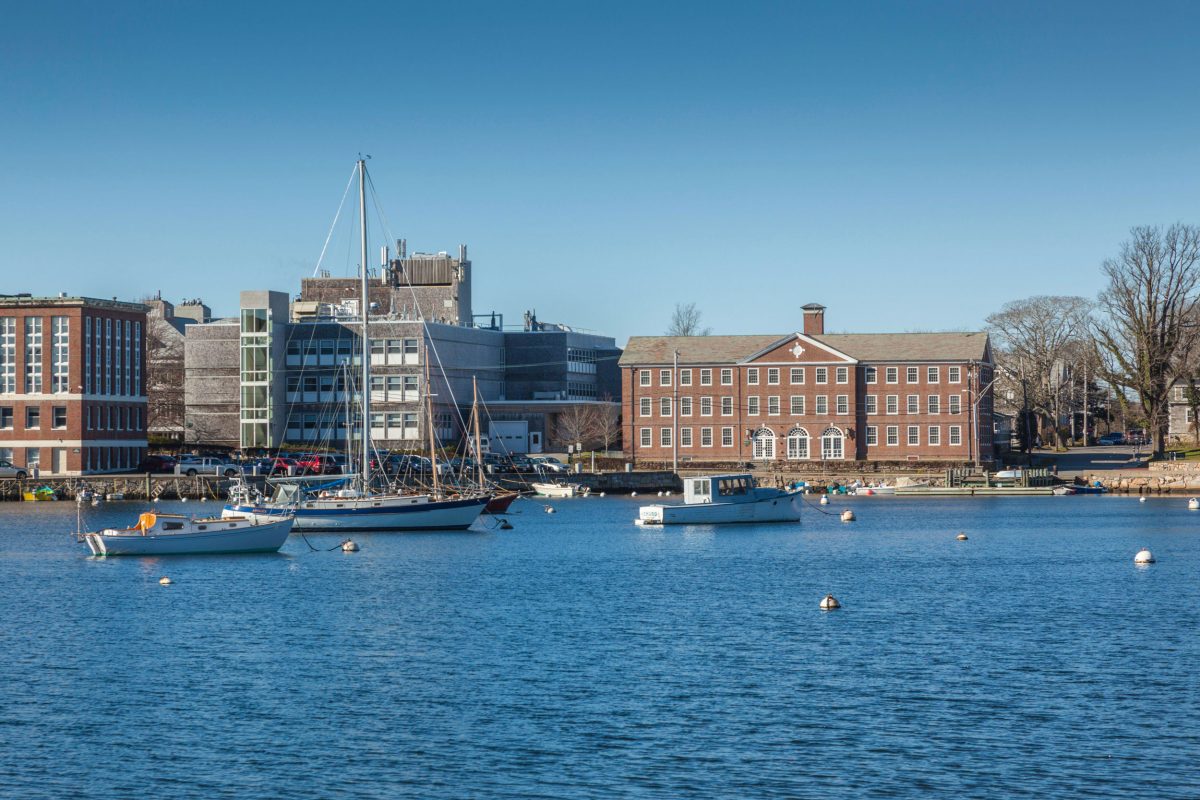
Woods Hole, Massachusetts, is home to three marine labs, which are cooperating with community members on plans to deal with the changing climate and how that will affect their shoreline. Photo by Danita Delimont/Alamy Stock Photo
In Woods Hole and many other coastal laboratories, the day of reckoning could still be decades away. LUMCON has little time to spare. Along Louisiana’s coast, the sea is projected to rise nearly one-third of a meter by the end of the decade—about twice as fast as in Massachusetts.
When construction began on the DeFelice Marine Center in 1983, architects knew that the edge of Terrebonne Bay was a precarious place. They designed an X-shaped building, which ensures no single wall is vulnerable to toppling in hurricane winds. As a safeguard against storm surge, the building’s four wings were set atop pillars four meters above the ground, which put them nearly six meters above sea level. Steel pilings sink about 36 meters into the underlying mud, providing a firm anchor. As if to mark the danger, four hurricanes struck the coast during the four years of construction.
But architects never considered sea level rise or the rapid subsidence of the marsh. As one of the building’s architects later put it to a student researcher, these two issues “were not even recognized as concerns.” Now, nearly four decades later, their combined forces are impossible to ignore. Roberts says that a few decades ago, cattle grazed 15 or so kilometers north of the facility. Today, the former pasture is open water.
That means it no longer takes a hurricane to deliver flooding. High tide can bring 30 centimeters of seawater rolling across the marine center property, high enough to force staff members to wade through shin-deep water. Combined with a strong wind, the flood can rise above 45 centimeters; these bigger floods leave behind thick layers of salty silt. In the early 2000s, high-water events happened several dozen times a year. Now, floods hit the parking lot on average once a week or more.
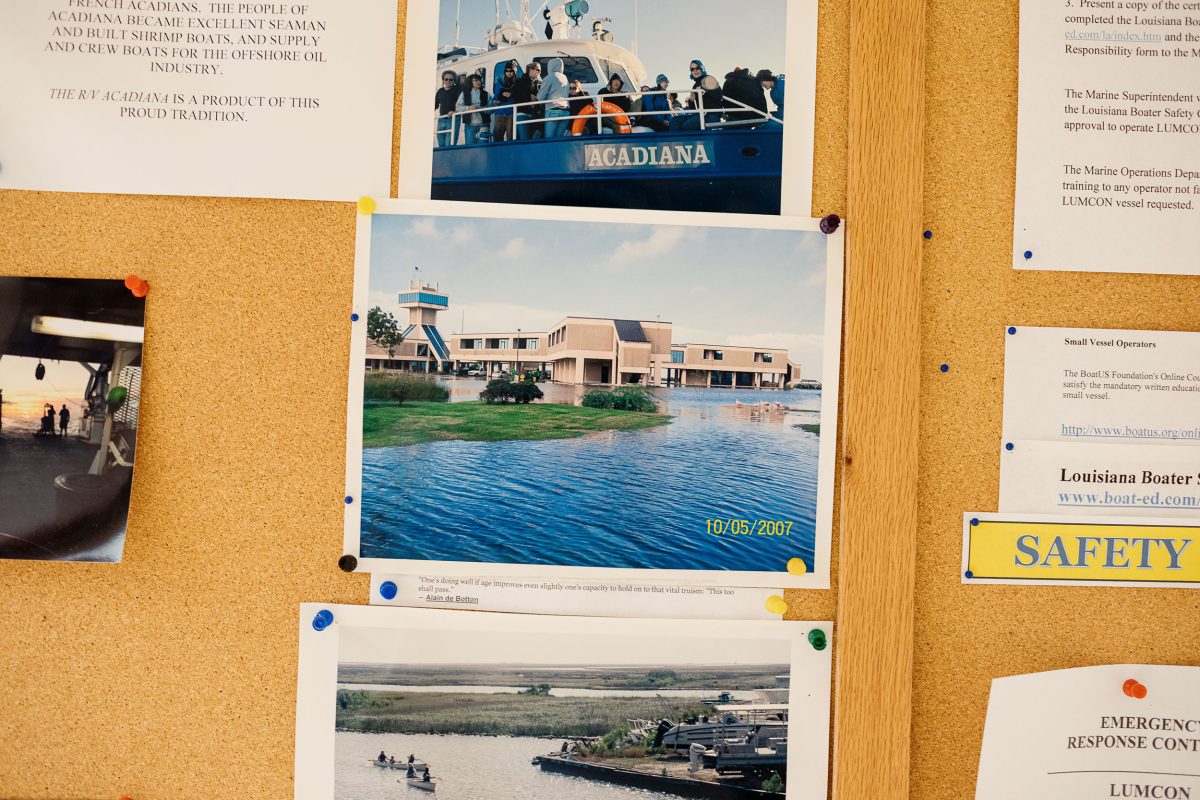
At the DeFelice Marine Center, if a school bus arrives for a field trip when the parking lot is flooded—a relatively common occurrence compared with a few decades ago—the education team takes the opportunity as a hands-on learning moment. Photo by Bryan Tarnowski
LUMCON’s education team, at least, has found a way to make the most of the flooding: if the parking lot is inundated when a school bus arrives for a field trip, the team has a flood curriculum ready to go. Still, the water is a nuisance. Most employees keep a set of rubber “car boots” in their trunk in case they arrive at work and find they have to trudge through the salty water; they have a second pair of “office boots” inside, in case the water arrives during the work day. (The summer education programs are known among staff as “white-boot school,” given the necessary fashion accessory.) Roberts checks the tide charts, so he can send a reminder to staff encouraging them to park on the highest ground, along the road.
Lifted on its piers, the marine center looks like a literal embodiment of the ivory tower metaphor. But, much like the institutions in Woods Hole, LUMCON has been working to be an integral part of the surrounding community. Earlier in 2021, LUMCON had begun to partner with the Pointe-au-Chien Indian Tribe, which is headquartered in a small village just northeast of Cocodrie, on a mapping project that depicts how the tribal community has shifted as Louisiana’s marshes have disappeared. “It means a lot,” says Cherie Matherne, the tribe’s cultural heritage and resiliency coordinator, “that they choose to reach out to us and want to help us on this.” The tribe is seeking official recognition from the US government and may wind up using the maps in their application.
Chris Tucker lives 20 kilometers north of Cocodrie, in the village of Chauvin—population 2,800—which is named for one of his great-grandfathers. He serves as the vice president of Chauvin Brothers, his family’s hardware business. He says he sees LUMCON as an anchor that has helped hold the town in place. Much of LUMCON’s support staff lives in Chauvin, so the institute has provided an economic lifeline, but Tucker also means the anchor metaphor more literally: to the west of Terrebonne Bay, he notes, the Atchafalaya River has been building new land; in the bay just to the east, the state of Louisiana has a plan to install a “diversion” that will hopefully do the same. Terrebonne Parish, though, sits between the two rivers; there is no large waterway that dumps mud into this bay. The state recently completed the reconstruction of several barrier islands here, meant to help soak up some of the energy of incoming storms. “If they weren’t here, would our area be getting the attention?” Tucker says. “If [LUMCON]’s not here, I think Terrebonne Parish slowly continues to die and lose land.”
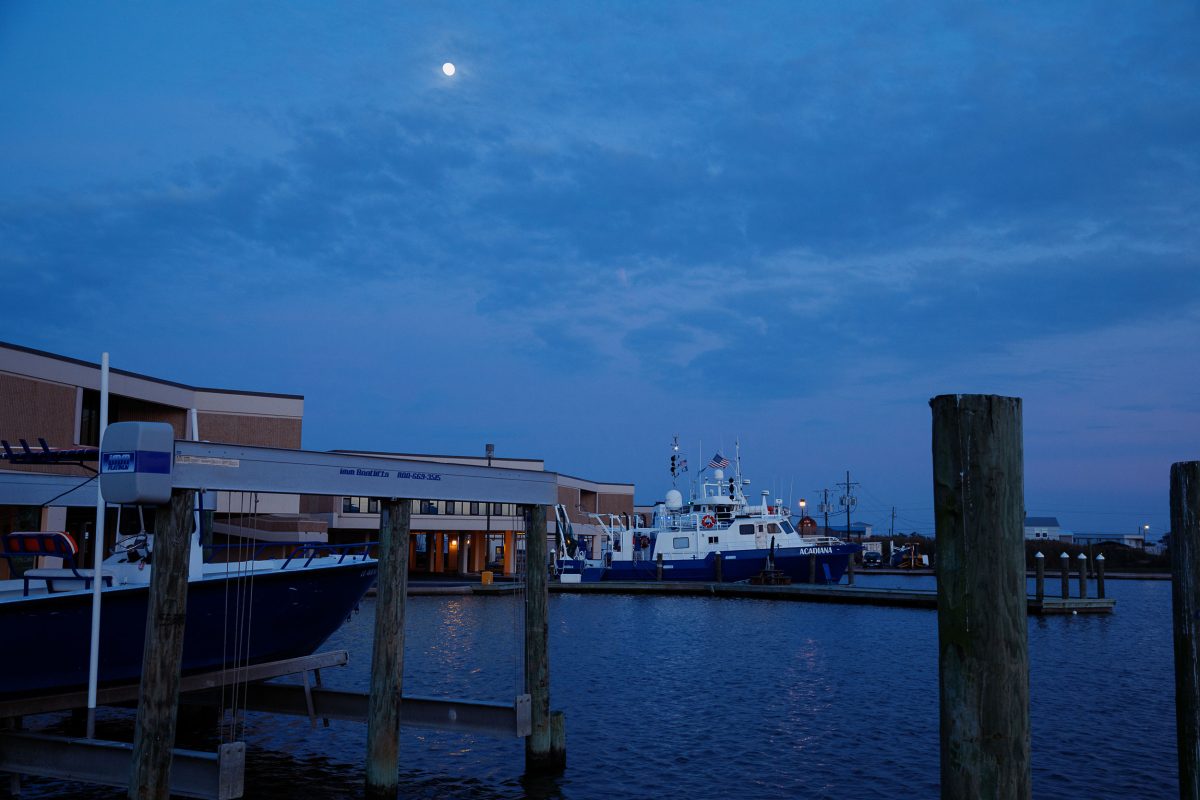
During hurricane season, the marine lab is in a constant state of preparedness. Photo by Bryan Tarnowski
Though many coastal residents are reluctant to leave, inland retreat is a likely necessity for many. Construction on LUMCON’s second campus in Houma began in 2021, before the storm. The facility is intended as an expansion, focused on engineering and technology education—thereby training future coastal workers and spurring technological development that will further LUMCON’s work. Still, it feels like a concession to climate change—a base of operations if Cocodrie has to go for a month without power again. Not that Houma was spared Ida’s fury: the town took a direct hit from the storm. The wind lifted one of LUMCON’s boats and its trailer and dumped them atop a pickup truck; all three were totaled, adding one more obstacle for LUMCON biologists who wanted to get out after the storm to see its effects on the aquatic ecosystems.
LUMCON can’t uproot itself entirely, given its mission, and has no intention to abandon the DeFelice Marine Center in Cocodrie. In 2017, the consortium convened a panel of staff members and outside experts to consider how to adapt. Most utility lines at the marine center are already underground to protect against wind damage, but the panel thought they could be wrapped in piping resistant to salt water, too. These days, Roberts says the most-discussed solutions are the construction of a new elevated parking deck, which could solve some flood problems, and the acquisition of a high-clearance vehicle that could carry employees to the facility from dry ground. A potential future, as the seas keep rising, could involve a ferry that departs from the edge of the hurricane-protection system: maybe even after Cocodrie is gone, LUMCON can remain, standing alone, rising from the Gulf.
During my visit in June, Ida’s lingering effects are easy to spot. One hallway is lined with small freezers, making up for the walk-in still broken. Because the floor of the aquaculture lab remains unstable, temporary tanks have been set up downstairs, beneath the building. Hurricane season has started again, and one of the research assistants I meet tells me she is nervous. The contractors are still making post-Ida repairs, so the weakened building is at greater risk of damage if another storm arrives, and more data could be lost.
Roberts admits that climate-induced hassles have become business as usual: “I hate to say that you grow somewhat accustomed to losing periods of time.” Even if a storm does not arrive in Cocodrie, its presence in the Gulf of Mexico can briefly derail a research project. Storms intensify so quickly now—with wind speed dramatically increasing in a matter of hours—that sometimes LUMCON must initiate its evacuation procedure before the storm tracks become clear.

One of the most tenacious forms of life—mold—has a field day after a hurricane whips through a region. After Ida, the marine lab used a temporary network of air ducts to keep mold at bay. Photo courtesy of LUMCON
Sometimes candidates are surprised to see the wide-ranging skills Roberts requires of his lab assistants, such as plumbing and wiring. But you have to be handy to work here. One of Roberts’s main research projects is an investigation into the effects of spilled oil on marsh ecosystems. He’s built a set of “mesocosms,” outdoor plots of marsh grass, where he can compare growth under various conditions. After a hurricane swamped Louisiana in 2019, the plots’ infrastructure—water systems, monitoring equipment—were ruined. Roberts and his team spent three days running hundreds of meters of electrical cabling; he knew if he had to wait on contractors, it might be weeks before his experiment was up and running again. Such challenges, though, are inextricable from the attraction of working at this place. “You’re trying to attract people that—being part of this is part of what they’ve signed up for,” he says. He wants people who are excited by the chance to work in a living laboratory—to live in what, for everyone else, is the climate future.
Roberts tells me that two weeks before my visit, on the first day of hurricane season, he had sent an email to LUMCON staff. He reminded everyone that after months in recovery mode, it was time to get prepared again: already a storm system was forming in the Gulf. That meant that probes, nets, and other equipment that had been left outside for easy access needed to be organized—so that, if it became necessary, evacuation would be quick.
The system out in the Gulf, as it turned out, dissipated. Nonetheless, the tide was high that day. Several centimeters of water pooled across the lot. One way or another, change is coming for LUMCON, and for this entire coastline. The rising water was at once a hassle and a reminder of why the work being done here is so vital.


